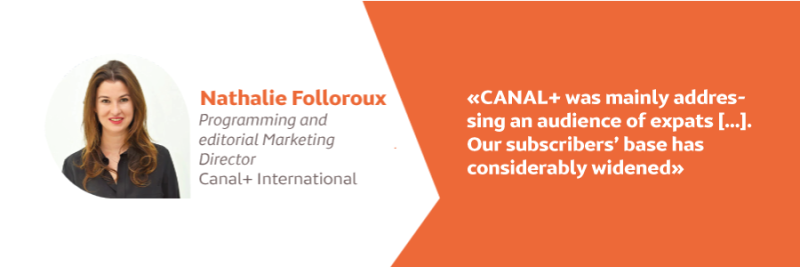African audiovisual landscape: Interview of Nathalie Folloroux, Canal+ International

Canal+ has been broadcast in Africa since 2001, could you please tell us more about your channels’ strategy in that market?
Back in 2011, CANAL+ was mainly addressing an audience of expats, who wanted to keep a link with their home tv stations.
As our subscribers’ base has considerably widened in the past few years, our channels have also evolved to address our new customers. The objective is to offer our customers, who for the most part now belong to the emerging middle class, programmes which meet their expectations.
Consequently, our programming includes more and more African programmes, to answer our customers’ need for proximity. Indeed, our customers partly want to be able to project and recognize themselves in the contents we broadcast.
These African programmes belong to several genres:
- Entertainment shows and factuals with a weekly entertaining comedy show called “Le Parlement du Rire”, a weekly documentary or informational magazine on Tuesdays in prime time – “Les Mardis de l’Afrique” - and a quaterly live musical show called “+ d’Afrique Live”.
- TV series: we have also started producing our own African series. We have been broadcasting short ones for a few months now, among which “Barbershop”, and currently on air “Chéri Coco”, our African adaptation of the world success format “Un gars une fille”, broadcasted at 20:25 pm on CANAL+. Long series are also in production and will soon be broadcasted.
- Last but not least, sport: under the CANAL+ brand, we produce four sport channels, CANAL+ SPORT 1, 2, 3, 4, and a very recent channel called A+ SPORT. On these channels, we broadcast international competitions but also several African sport competitions, among which “La Coupe d’Afrique des Nations”, “Le FIBA Afrobasket” or cycling competitions such as “Le Tour du Faso”, and we produce several sport magazines such as “Talents d’Afrique” or “Onze d’Europe”.
In addition to our CANAL+ TV stations, our strategy is also to produce specific additional TV stations for the African audience, such as A+, Nollywood TV, or Novelas TV.
In your opinion, what are the key factors to take into consideration for a television channel that wants to enter the African market?
The key factors to take into consideration are, as in any market, the specific tastes of the audiences you want to address.
In Africa, we witness as explained above, that our audiences wish to watch local programmes, whether sport, fictions or shows, produced with high quality. There should not be a difference in the quality of production between international programmes and African ones. This is what we endeavor to achieve with our local productions in CANAL+.
Nevertheless, this wish for local programmes doesn’t mean that Africans do not want to watch international programmes, and cinema, especially blockbusters, as well as series, wherever they may be coming from, are also among their favorite programmes.
What are the recent initiatives to notice in the African audiovisual landscape?
There are several initiatives to notice in the African audiovisual landscape:
- The first one which has been going on for a few years now is the renewing of pan African channel, i.e. channels specifically created for the African market: I have already mentioned our own channels, A+, Novelas TV and Nollywood TV, and a very recently launched one, Nollywood Epic. Other media groups have also joined this trend, among which BBLack, Edan, and Fashion Africa.
- The second is the switch to Digital Terrestrial Television, in several countries, among which Ivory Coast, where Canal+ has obtained a license for a free to air TV station, and will thus start his first FTA experience in Africa.
- The third one is the professionalization of the producing industry, and not only in South Africa or Nigeria, but also in French speaking countries, such as Senegal, Ivory Coast or Burkina Faso, where productions thrive.
Test of significance of the differences between two proportions
Used to assess whether the difference between 2 proportions is significant at the 95% threshold
Warning: only applies to a proportion. The Average Rate is an average of proportions and the Audience Share a ratio of proportions. This tool is provided for information purposes. It cannot be applied for professional purposes without further precautions.
des médias
edition
definitions